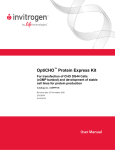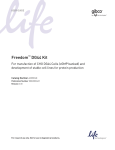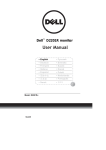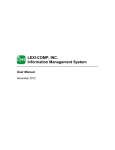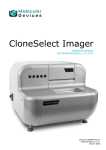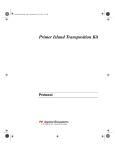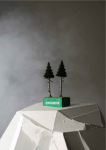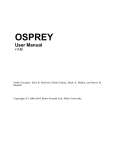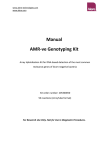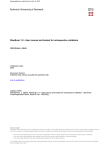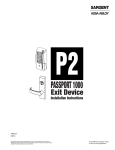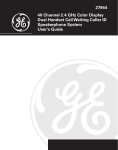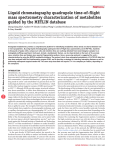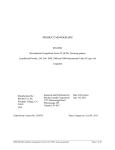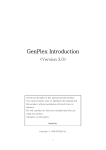Download OptiCHO Antibody Express Kit
Transcript
OptiCHO™ Antibody Express Kit For transfection of DG44 cells and development of stable cell lines for antibody production Catalog no. 12762-019 Version B 4 November 2010 25-1009 Corporate Headquarters Invitrogen Corporation 1600 Faraday Avenue Carlsbad, CA 92008 T: 1 760 603 7200 F: 1 760 602 6500 E: [email protected] For country-specific contact information visit our web site at www.invitrogen.com User Manual ii Table of Contents Table of Contents ................................................................................................................................................. iii Kit Contents and Storage .................................................................................................................................... iv Accessory Products............................................................................................................................................... v Introduction ................................................................................................................... 1 Overview.................................................................................................................................................................1 DG44 Cells ..............................................................................................................................................................4 CD DG44 Medium .................................................................................................................................................5 FreeStyle™ MAX Reagent......................................................................................................................................6 CD OptiCHO™ Medium........................................................................................................................................7 Methods ......................................................................................................................... 8 Testing Constructs by Transfection.....................................................................................................................8 Thawing and Subculturing DG44 Cells ............................................................................................................10 Freezing DG44 Cells ............................................................................................................................................12 Transfecting DG44 Cells with FreeStyle™ MAX Reagent ...............................................................................13 Selecting for Stable Transformants....................................................................................................................16 Choosing a Workflow .........................................................................................................................................17 Genomic Amplification by MTX Selection .......................................................................................................18 Clonal Selection in Semi-Solid Media ...............................................................................................................19 Clone Scale-Up .....................................................................................................................................................21 Troubleshooting .......................................................................................................... 22 Appendix...................................................................................................................... 24 Technical Support ................................................................................................................................................24 Purchaser Notification ........................................................................................................................................25 Product Qualification ..........................................................................................................................................26 References .............................................................................................................................................................27 Notes......................................................................................................................................................................28 iii Kit Contents and Storage Shipping/Storage The components of the OptiCHO™ Antibody Express Kit are shipped and should be stored as listed below. TOPO® TA Cloning The pOptiVEC™-TOPO® TA and pcDNA™3.3-TOPO® TA cloning reagents are shipped on dry ice in two separate boxes, containing the cloning reagents and the Reagents One Shot® TOP10 Chemically Competent E. coli kits. Refer to the manuals for pOptiVEC™-TOPO® TA Cloning Kit and pcDNA™3.3-TOPO® TA Kit for detailed descriptions of these kit contents. Store the TOPO® reagents at -20ºC and the One Shot® TOP10 Chemically Competent E. coli kit at -80°C. DG44 cells are provided as one vial shipped on dry ice containing 1 x 107 cells in 1 ml freezing medium containing 10% DMSO. DG44 cells Important: Upon receipt, immediately store in liquid nitrogen. OptiCHO™ Antibody Express Kit Components The OptiCHO™ Antibody Express Kit components are shipped under various conditions as listed below. Store components as indicated. Item ™ FreeStyle MAX Reagent Amount Shipping Storage 1 ml Blue ice +4ºC, Do not Freeze OptiPro SFM 100 ml Room temperature +4ºC CD DG44 Medium 1000 ml Room temperature +4ºC, in the dark 1000 ml Room temperature +4ºC, in the dark Geneticin , 50 mg/ml 100 ml Room temperature +4°C L-glutamine, 200 mM 100 ml Dry ice -20ºC 100 ml Room temperature Room temperature ™ ™ CD OptiCHO Medium ® ® Pluronic F-68, 10% iv Accessory Products Introduction The products listed in this section may be used with the OptiCHO™ Antibody Express Kit. For more information, go to www.invitrogen.com or contact Technical Support (see page 24). Item Amount pOptiVEC -TOPO TA Cloning Kit pcDNA™3.3-TOPO® TA Cloning Kit One Shot® TOP10 Chemically Competent E. coli 1 kit 1 kit 10 reactions 20 reactions 25 preps 1 ml 100 ml 1000 ml 100 ml 100 ml 100 ml 1000 ml 1000 ml 1 x 107 cells 500 ml ™ ® PureLink™ HiPure Plasmid Midiprep Kit FreeStyle™ MAX Reagent OptiPro™ SFM L-glutamine, 200 mM, liquid Pluronic® F-68, 10% Trypan Blue Stain CD DG44 Medium CD OptiCHO™ Medium DG44 Cells CD OptiCHO™ Cloning Medium (2x) Gibco® Custom Media Catalog no. 12744-017 K8300-01 C4040-10 C4040-03 K2100-04 16447-100 12309-050 12309-019 25030-081 24040-032 15250-061 12610-010 12681-011 12609-012 07-0040DJ Through our Gibco® custom media services, we can develop cloning or growth media formulations specifically suited to your cells. We can provide the best nutrient media delivery scheme for your recombinant cell line, optimizing a Gibco® medium or one in the public domain, or your own formulation. All final media manufacturing is performed in our ISO-9001 certified, QSR/cGMPcompliant facilities and held to the same high standards as our own Gibco® catalog products, ensuring scalability, robustness, and compliance. For more information, go to www.invitrogen.com or contact Technical Support (see page 24). v vi Introduction Overview OptiCHO™ Antibody Express Kit The OptiCHO™ Antibody Express Kit is designed for easy cloning and expression of recombinant antibodies in dihydrofolate reductase (DHFR)-deficient, Chinese hamster ovary (CHO)-derived DG44 cells in suspension culture. The OptiCHO™ Antibody Express Kit provides reagents for cloning the gene encoding the heavy and light chains of your antibody, high efficiency transfection of the DNA constructs into DG44 cells, and generation of stable cell lines producing your antibody of interest. Components of the OptiCHO™ Antibody Express Kit The OptiCHO™ Antibody Express Kit includes the following major components: • pOptiVEC™-TOPO® TA Cloning Kit: A TOPO®-adapted bicistronic plasmid and reagents for cloning a PCR product containing a mammalian secretion signal and the heavy and light chains, separately, of your antibody of interest. See the next page for more information. • pcDNA™3.3-TOPO® TA Cloning Kit: A TOPO®-adapted plasmid and reagents for cloning a PCR product containing a mammalian secretion signal and the heavy and light chains, separately, of your antibody of interest. See the next page for more information. • DG44 cells: DHFR-negative, CHO-derived cells adapted to high density, serum-free suspension culture in CD DG44 Medium that are capable of producing high levels of secreted, recombinant protein. See page 4 for more information. • CD DG44 Medium: Defined, serum-free medium supplemented with hypoxanthine and thymidine to allow growth of DHFR-negative DG44 cells. See page 5 for more information. • FreeStyle™ MAX Reagent: A proprietary, animal origin-free formulation for high transfection efficiency of plasmid DNA into DG44 cells. See page 6 for more information. • CD OptiCHO™ Medium: Defined, serum-free medium formulated for selection and growth of DG44 cells expressing DHFR and the recombinant protein of interest. See page 7 for more information. The kit also contains OptiPro™ serum free medium (SFM) for optimal DNA:lipid complex formulation, L-glutamine provided separately for increased media stability, Geneticin® for stable cell line selection, and the surfactant Pluronic® F-68 to control shear forces in suspension culture. 1 Overview, continued Advantages of the OptiCHO™ Antibody Express Kit The OptiCHO™ Antibody Express Kit provides the following advantages for antibody production in mammalian cells: • DHFR-deficient DG44 cells derived from CHO cells (Urlaub et al., 1983), which provide stable and accurate glycosylation (Sheeley et al., 1997; Werner et al., 1998) and are more likely to yield accurate glycoproteins. • FreeStyle™ MAX Reagent offers high transfection efficiency of suspension CHO cells with low cytotoxicity. • FreeStyle™ MAX Reagent, CD DG44 Medium and CD OptiCHO™ Medium are animal-origin and serum-free. TOPO® TA Cloning The OptiCHO™ Antibody Express Kit contains the pOptiVEC™-TOPO® TA Cloning Kit and the pcDNA™3.3-TOPO® TA Cloning Kit (also available Vector Kits separately, see page v for details). The pOptiVEC™-TOPO® TA Cloning Kit contains the pOptiVEC™-TOPO® vector, a TOPO®-adapted bicistronic plasmid that allows rapid cloning of a PCR product containing a mammalian secretion signal and the gene of interest downstream of the CMV promoter. In the pOptiVEC™-TOPO® vector, the transcription of the gene of interest is separated from the dihydrofolate reductase (DHFR) auxotrophic selection marker by an internal ribosome entry site (IRES), allowing transcription of the gene of interest and the selection marker on the same mRNA. The pcDNA™3.3-TOPO® TA Cloning Kit contains the pcDNA™3.3-TOPO® vector, a TOPO®-adapted plasmid that allows rapid cloning of a PCR product containing a mammalian secretion signal and the gene of interest downstream of the CMV promoter. The pcDNA™3.3-TOPO® contains a neomycin resistance gene, slowing selection using Geneticin®. Continued on next page 2 Overview, continued Experimental Outline Important: Refer to the pOptiVEC™-TOPO® TA Cloning Kit and pcDNA™3.3TOPO® TA Cloning Kit manuals included with the kit for detailed information on cloning the heavy and light chains of your antibody of interest into these vectors prior to Step 1, below. This manual provides instructions and guidelines to perform the following steps: Step Action 1 Transiently transfect CHO cells (or stably transfect DG44 cells) with pOptiVEC™-TOPO® and pcDNA™3.3-TOPO® plasmid constructs to determine which vector combination gives optimal antibody yield. 2 Thaw and propagate DG44 cells in CD DG44 Medium. 3 Transfect your pOptiVEC™-TOPO® and pcDNA™3.3-TOPO® plasmid constructs into DG44 cells using FreeStyle™ MAX Reagent. 4 Select for a pool of stably transfected cells by performing two rounds of selection using CD OptiCHO™ Medium and CD OptiCHO™ Medium with Geneticin®. 5 Perform MTX amplification and clonal selection using limiting dilution on semi-solid media. 6 Scale up your high-producing clonal cell line to suit your bioproduction needs. 3 DG44 Cells Introduction The DG44 cell line is a dihydrofolate reductase (DHFR)-deficient cell line derived from suspension Chinese hamster ovary (CHO-S) cells (Urlaub et al., 1983). DG44 cells are adapted to suspension culture in CD DG44 Medium. Frozen cells are supplied at 1 x 107 cells/ml and may be thawed directly into CD DG44 Medium (see Thawing and Subculturing Cells, page 8). Parental Cell Line The CHO-S cell line is a stable aneuploid cell line established from the ovary of an adult Chinese hamster (Puck, 1958). CHO cells are commonly used cell lines for transfection, expression, and large-scale production of recombinant proteins. DHFR DHFR catalyzes the reduction of 5, 6-dihydrofolate to 5, 6, 7, 8-tetrahydrofolate, which is essential for DNA synthesis. CHO-derived DG44 cells lack DHFR activity and must be propagated in medium containing the purine precursors hypoxanthine and thymidine (HT) unless the cells are stably transfected with a vector that expresses DHFR. DHFR also functions as a genomic amplification marker for your gene of interest using methotrexate (MTX) selection (Kaufman et al., 1985; Tanaka et al., 2002). See page 18 for more details on genomic amplification using MTX. Characteristics of DG44 Cells The DG44 cell line exhibits the following characteristics: • Adapted to serum-free suspension growth in CD DG44 Medium containing hypoxanthine and thymidine • Demonstrates high transfection efficiencies with FreeStyle™ MAX Reagent • Suspension cultures may be transfected in CD DG44 Medium As with other human cell lines, when working with DG44 cells, handle as potentially biohazardous material under at least Biosafety Level 2 containment. 4 CD DG44 Medium Introduction CD DG44 Medium is a defined, serum-free medium containing hypoxanthine and thymidine for high-density suspension culture of untransfected DG44 cells. The medium contains no human or animal origin components. Features of CD DG44 Medium CD DG44 Medium has the following features: Making Complete CD DG44 Medium • Chemically defined, containing no proteins or peptide components of animal, plant, or synthetic origin, and no undefined hydrolysates or lysates • Supplemented with hypoxanthine and thymidine (HT) for growth of DHFR-negative cells • Formulated without L-glutamine to avoid problems associated with L-glutamine degradation, including ammonia accumulation • Formulated without Pluronic® F-68 • Formulated without phenol red to minimize potential estrogen-like effects • CD DG44 Medium requires supplementation with L-glutamine. Aseptically add L-glutamine to a final concentration of 8 mM to the medium before use. • CD DG44 Medium requires the addition of a surfactant to protect against shear forces in suspension culture. Aseptically add 18 ml/L of Pluronic® F-68 to the medium before use. Caution: Pluronic® F-68 is an irritant to the eyes, respiratory system and skin. Review the Material Safety Data Sheet (MSDS) before use. • Growth Characteristics of DG44 Cells in CD DG44 Store complete CD DG44 Medium at 4ºC, protected from light. Typically, DG44 cells cultured in CD DG44 Medium have a doubling time in the range of 16-22 hours (doubling time can exceed 22 hours during the first few passages after the cells have been thawed.) Do not allow DG44 cells to reach a cell density above 1 x 106 cells/ml before transfection, as this will result in a decrease of transfection efficiency. Individual culturing and passaging techniques coupled with cellular heterogeneity inherent within the DG44 cell population may result in experimental variability. 5 FreeStyle™ MAX Reagent FreeStyle™ MAX Reagent FreeStyle™ MAX Reagent is a proprietary, animal origin-free formulation for the highly efficient transfection of plasmid DNA into eukaryotic cells. FreeStyle™ MAX Reagent is specifically formulated to achieve the highest expression levels and lowest cytotoxicity in DG44 cells and other suspension cell lines, including FreeStyle™ CHO-S and FreeStyle™ 293-F cells. Store FreeStyle™ MAX Reagent at 4ºC. Do not freeze. FreeStyle™ MAX Reagent is also available separately from Invitrogen; see page v for more information. OptiPro™ SFM OptiPro™ SFM is included with the OptiCHO™ Antibody Express Kit to facilitate optimal formation of DNA-lipid complexes. OptiPro™ SFM is a serum-free medium that is devoid of any components of animal or human origin. OptiPro™ SFM has an ultra-low protein concentration of 7.5 µg/ml. Store OptiPro™ SFM at 4ºC. OptiPro™ SFM is available separately from Invitrogen; see page v for ordering information. 6 CD OptiCHO™ Medium Introduction Important Features of the Medium Making Complete CD OptiCHO™ Media CD OptiCHO™ Medium is a defined, serum-free medium for selection and highdensity suspension culture of stably-transfected DG44 cells expressing DHFR and the neomycin resistance gene. You will perform two rounds of selection on your transfected cells, one with CD OptiCHO™ medium and one with CD OptiCHO™ and 500 μg/ml Geneticin®, as detailed on page 16. Do not use CD OptiCHO™ Medium or CD OptiCHO™ Medium + Geneticin® to propagate untransfected or parental DG44 cells. DG44 cells are DHFR-deficient and require supplementary hypoxanthine and thymidine (HT). • Only cells that have an active DHFR enzyme, or have been transfected with pOptiVEC™-TOPO® can be propagated in CD OptiCHO™ Medium. • Only cells that have an active DHFR enzyme, or have been transfected with pOptiVEC™-TOPO® and pcDNA™3.3-TOPO® constructs can be propagated in CD OptiCHO™ Medium + Geneticin®. CD OptiCHO™ Medium has the following features: • Chemically defined, containing no proteins or peptide components of animal, plant or synthetic origin, and no undefined hydrolysates or lysates • Formulated without L-glutamine to avoid problems associated with L-glutamine degradation, including ammonia accumulation • Formulated without phenol red to minimize potential for estrogen-like effects of phenol red • CD OptiCHO™ Medium requires supplementation with L-glutamine. Aseptically add L-glutamine to a final concentration of 8 mM to the medium before use. • For Geneticin® selection, aseptically add Geneticin® to CD OptiCHO™ Medium at a concentration of 500 μg/ml. • Store complete media at 4ºC protected from light. 7 Methods Testing Constructs by Transfection Prior to making stable transfectants in DG44 cells. You may perform transient transfections of CHO cells (see Recommendation, next page) with pOptiVEC™TOPO® and pcDNA™3.3-TOPO® plasmid constructs to determine which vector combination gives optimal antibody yield using your detection method of choice. Introduction You may also perform several stable transfections of DG44 cells with various combinations of pOptiVEC™-TOPO® and pcDNA™3.3-TOPO® plasmid constructs. See page 15 for protocol. ® 1. TOPO clone mammalian secretion signal (SS) /heavy chain and SS/light chain separately into both into pOptiVECTM-TOPO® and pcDNA3.3TM-TOPO®. IR E P V CM Light SS TK p A P P 40 SV TK pA or C i N e o m y c in TM Heavy Chain pU pA TK p A pcDNA3.3 icillin or + Am p D HFR Heavy S 40 Light Chain C SV P CM TM pU i V IR E pOptiVEC icillin C or Am p TM Light Chain pU C TK pcDNA3.3 icillin pU i + Am p i c i ll i n or pA V P CM 40 SV S Amp TM pOptiVEC Heavy Chain SS Light N e o m y cin V CM SS pA P Heavy Heavy DHFR SS i SV 40 2. Transiently transfect each set of clones into CHO cells -ORperform stable transfections in DG44 cells. 3. Wait 5-7 days for transient transfection in CHO cells -ORSelect cells using CD OptiCHO (- HT) + Geneticin® for stable transfection in DG44. 4. Assay for antibody production using method of choice. 5. Choose the vector combination that gives the highest antibody production level, and proceed to stable transfection in DG44 cells -ORDetermine which stably transfected DG44 pool gives highest antibody production level and proceed to clone selection and/or amplification. Continued on next page 8 MEND ION AT RECOM Testing Constructs by Transfection, Continued Plasmid Preparation We recommend FreeStyle™ CHO-S cells and transfection with FreeStyle™ MAX Reagent for transient transfection. Both FreeStyle™ CHO-S cells and FreeStyle™ CHO Expression Medium are available separately from Invitrogen, see page v. The pOptiVEC™ and pcDNA™3.3 plasmid constructs must be clean, sterile, and free from contamination with phenol and sodium chloride for transfection into cells. Contaminants may kill the cells, and salt will interfere with lipid complexing, decreasing transfection efficiency. We recommend isolating plasmid DNA using the PureLink™ HiPure Plasmid Midiprep DNA Kit (see page v for ordering information). Note: Plasmids may be linearized or circular for transient transfection. For stable transfection of DG44 cells, we recommend linearizing the plasmid, see page 13. General Guidelines To transiently transfect FreeStyle™ CHO-S cells, use equal amounts of each for Transient pOptiVEC™ and pcDNA™3.3 plasmid DNA constructs containing the heavy and light chains of your antibody and follow the recommended protocol included Transfection with your CHO cells and transfection reagent. After transfection, culture cells for 5-7 days (no medium change is required) and assay for antibody production using your method of choice (see below). Antibody Production To check for production of your antibody after transient transfection, you may take an aliquot of growth media and perform SDS-PAGE, protein-specific ELISA, or the bioactivity assay of choice to determine that your cells are producing your antibody of interest. 9 Thawing and Subculturing DG44 Cells Introduction Important Preparing Complete CD DG44 Medium Follow the protocol below to thaw DG44 cells. Cells are supplied in a vial containing 1 ml of cells at 1 x 107 viable cells/ml in 90% freezing medium and 10% DMSO. Thaw DG44 cells directly into CD DG44 Medium supplemented with 8 mM L-glutamine and 18 ml/L Pluronic® F-68. Do not thaw and grow DG44 cells in CD OptiCHO™ Medium. Parental or untransfected DG44 cells are DHFR-negative and require supplementary hypoxanthine and thymidine, present in CD DG44 Medium. • • • • Materials Needed All solutions and equipment that come in contact with the cells must be sterile. Always use proper sterile technique and work in a laminar flow hood. Supplement CD DG44 Medium to a final concentration of 8 mM L-glutamine and 18 ml of 10% Pluronic® F-68 per liter before use (see page 5). Addition of antibiotics is not recommended. CD DG44 Medium is light sensitive. For optimal results, store medium at 4ºC, protected from light. You should have the following reagents and materials before beginning: • Frozen DG44 cells (supplied with the kit; store frozen cells in liquid nitrogen until ready to use) • Complete CD DG44 Medium (prepared as above; pre-warm at 37°C before use) • 125 ml polycarbonate, disposable, sterile Erlenmeyer flasks with vented caps (available from VWR, West Chester PA, cat. no. 30180-036) • Orbital shaker set at 130-135 rpm in 37°C incubator with a humidified atmosphere of 8% CO2 Continued on next page 10 Thawing and Subculturing DG44 Cells, continued Thawing Procedure Determining Cell Density and Viability To thaw and establish cells: 1. Remove the cryovial of cells from the liquid nitrogen and thaw quickly (<1 minute) in a 37°C water bath. 2. Decontaminate the outside of the vial with 70% ethanol. Gently break up any clumps with a sterile pipette tip and aseptically transfer the entire contents of the cryovial into a disposable, sterile polycarbonate 125-ml Erlenmeyer shaker flask containing 30 ml of pre-warmed complete CD DG44 Medium. 3. Incubate cells in a 37°C incubator containing a humidified atmosphere of 8% CO2 in air on an orbital shaker platform rotating at 130-135 rpm. 4. After 24-48 hours in culture, determine the cell density and viability using the protocol described below. 5. Once the culture has reached > 1.2 x 106 viable cells/ml, expand cultures using the subculturing protocol below. Follow the procedure below to determine viable and total cell counts. 1. Transfer a small aliquot of the cell suspension to a microcentrifuge tube. 2. Determine viability using trypan blue dye exclusion. 3. Determine cell density electronically using a Coulter Counter or manually using a hemacytometer and an inverted microscope. Subculturing Cells Passage the cells once the culture has reached >1.2 x 106 viable cells/ml. When passaging DG44 cells, use disposable, sterile polycarbonate 125-ml Erlenmeyer shaker flasks with vented caps containing 30 ml of pre-warmed complete CD DG44 Medium. Important 1. Determine viable and total cell counts. 2. Using the cell density determined in Step 1, calculate the split ratio needed to seed each new shaker flask at 2 x 105 viable cells/ml by dilution. 3. Dilute the cells in 30 ml of pre-warmed complete CD DG44 Medium to give a final cell density of 2 x 105 viable cells/ml. 4. Incubate flasks in a 37°C incubator containing a humidified atmosphere of 8% CO2 in air on an orbital shaker platform rotating at 130-135 rpm. 5. Repeat Steps 1-4 as necessary to maintain or expand cells. After 25 passages, you should thaw a new vial of cells. To maintain sufficient stocks of low-passage cells (i.e., under 25 passages), be sure to freeze aliquots of DG44 cells in liquid nitrogen. See the next section for instructions on cryopreserving cells. 11 Freezing DG44 Cells Introduction You may freeze DG44 cells directly in CD DG44 Medium with 10% DMSO. We recommend that you freeze cells at a density of ≥ 1 x 107 viable cells/ml. Guidelines to prepare freezing medium and to freeze cells are provided in this section. Materials Needed You will need the following reagents and equipment before starting: • Complete CD DG44 Medium • Tissue culture grade DMSO • Reagents and equipment to determine viable and total cell counts • Sterile, labeled cryovials • Sterile, 15 ml-conical tubes • Automated or manual controlled-rate freezing apparatus Preparing Freezing Medium Prepare freezing medium immediately before use. 1. In a sterile, conical centrifuge tube, mix together the following reagents for every 1 ml of freezing medium needed: Complete CD DG44 Medium DMSO Freezing Cells 0.9 ml 0.1 ml 2. Filter-sterilize the freezing medium through a 0.22 µm filter and place the tube on ice until use. Discard any remaining freezing medium after use. 1. Grow the desired quantity of DG44 cells in shaker flasks, harvesting when the cell density reaches 1 x 106 viable cells/ml. Transfer cells to a sterile, conical centrifuge tube. 2. Determine the viable and total cell counts and calculate the volume of freezing medium required to yield a final cell density of 1 x 107 viable cells/ml. 3. Centrifuge cells at 1,200 rpm for 5 minutes at room temperature and carefully aspirate the medium. 4. Resuspend the cells in the pre-determined volume of chilled freezing medium. 5. Place cryovials in a microcentrifuge rack and aliquot 1 ml of the cell suspension into each cryovial. 6. Freeze cells in an automated or manual controlled-rate freezing apparatus following standard procedures. For ideal cryopreservation, the freezing rate should be a decrease of 1°C per minute. 7. Transfer frozen vials to liquid nitrogen for long-term storage. Note: You may check the viability and recovery of frozen cells 24 hours after storing cryovials in liquid nitrogen by following the thawing procedure on page 11. 12 Transfecting DG44 Cells with FreeStyle™ MAX Reagent Introduction You will use FreeStyle™ MAX Reagent to transfect suspension DG44 cells with the combination of pOptiVEC™-TOPO® and pcDNA™3.3-TOPO® constructs that gave you the highest yield of antibody (from page 9). Plasmid Preparation The pOptiVEC™ and pcDNA™3.3 plasmid constructs must be clean, sterile, and free from contamination with phenol and sodium chloride for transfection into DG44 cells. Contaminants may kill the cells, and salt will interfere with lipid complexing, decreasing transfection efficiency. We recommend isolating plasmid DNA using the PureLink™ HiPure Plasmid Midiprep DNA Kit (see page v for ordering information). Linearizing the Plasmids Prior to using the OptiCHO™ Antibody Express Kit to transfect DG44 cells with your pOptiVEC™ and pcDNA™3.3 constructs, you may linearize the plasmids. While linearizing your vectors may not improve transfection efficiency, it increases the chance that the vectors will integrate into the host cell genome without disrupting the gene of interest or other elements required for expression in mammalian cells. • We suggest using Pvu I, which cuts once in the ampicillin resistance gene on each plasmid. Other unique restriction sites are possible. Complete restriction maps of pOptiVEC™-TOPO® and pcDNA™3.3-TOPO® are available at www.invitrogen.com. Be sure that your inserts do not contain the restriction enzyme site you use to linearize the vector. Note: If an appropriate linearization site is not present, you may transfect the circular plasmid. Transfection efficiency will not be affected. • After digestion, precipitate the DNA, resuspend pellet in sterile water, and re-quantify using your method of choice. Continued on next page 13 MEND ION AT RECOM Transfecting DG44 Cells with FreeStyle™ MAX Reagent, continued Materials Needed Optimal Transfection Conditions Calculate the number of DG44 cells that you will need for your transfection experiment and expand cells accordingly. Make sure that the cells are healthy and greater than 95% viable before proceeding to transfection. You should have the following reagents and equipment before beginning: • Suspension DG44 cells cultured in complete CD DG44 Medium at 5 x 105 cells/ml • Purified, linearized pOptiVEC™-TOPO® and pcDNA™3.3-TOPO® plasmids DNA containing your heavy and light chains of interest, as determined from page 9 • FreeStyle™ MAX Reagent (supplied with the kit; store at +4°C until use) • OptiPro™ SFM (supplied with the kit; pre-warmed to room temperature) • Disposable, sterile, 125-ml polycarbonate Erlenmeyer flasks • Orbital shaker in 37°C incubator with a humidified atmosphere of 8% CO2 • Reagents and equipment to determine viable and total cell counts (e.g., Trypan Blue, hemacytometer, Coulter Counter) To transfect suspension DG44 cells in a 30 ml volume, we recommend using the following optimized conditions: • Final transfection volume: 30 ml • Number of cells to transfect: total of 1.5 x 107 cells (cell density at time of transfection should be 5 x 105 cells/ml) • Amount of each plasmid DNA: 9 μg each (total 18 µg) • FreeStyle™ MAX Reagent: 15 µl Note: Further optimization of culture volume or transfection conditions is not necessary for stable cell line production. Continued on next page 14 Transfecting DG44 Cells with FreeStyle™ MAX Reagent, continued Transfection Procedure Follow the procedure below to transfect DG44 cells in a 30-ml volume. We recommend including negative controls (no DNA, no FreeStyle™ MAX Reagent) in your experiment to help you evaluate your results. 1. At 48 hours before transfection, pass DG44 cells at 3 x 105 cells/ml in complete CD DG44 Medium. Place the flask(s) on an orbital shaker platform rotating at 130-135 rpm at 37°C, 8% CO2. 2. At 24 hours before transfection, pass DG44 cells at 3 x 105 cells/ml in complete CD DG44 Medium. Place the flask(s) on an orbital shaker platform rotating at 130-135 rpm at 37°C, 8% CO2. 3. On the day of transfection, perform a viable cell count. To ensure optimal transfection results, viability of cells must be over 95%. 4. For each transfection or control, transfer 1.5 x 107 viable DG44 cells to a new 125-ml flask. Add pre-warmed, complete CD DG44 Medium to a final volume of 30 ml. Place flask in shaker until ready to transfect. Note: Do not spin cells down prior to transfection, as it will decrease transfection efficiency. 5. Gently invert the tube of FreeStyle™ MAX Reagent several times to mix. Do not vortex. 6. Add 18 µg of plasmid DNA (9 μg of each construct) and 15 µl of FreeStyle™ MAX Reagent into 1.2 ml of OptiPro™ SFM and mix gently. 7. Incubate the DNA-FreeStyle™ MAX mix for 10 minutes at room temperature to allow complexes to form. Do not incubate for longer than 20 minutes. 8. Slowly add 1.2 ml of DNA-FreeStyle™ MAX Reagent complex into the 125-ml flask containing cells while slowly swirling the flask. 9. Incubate transfected cell cultures at 37°C, 8% CO2 on an orbital shaker platform rotating at 130-135 rpm. 10. At 48 hours post transfection, pass cells into HT-deficient, complete CD OptiCHO™ Medium (see page 7). Proceed to the next section, Selecting for Stable Transformants. 15 Selecting for Stable Transformants Introduction To obtain cell lines that produce high levels of your protein, you will first need to select for a pool of stably-transfected cells, in which the linearized pOptiVEC™ and pcDNA™3.3 constructs have integrated into the host cell genome. You will perform two rounds of selection using CD OptiCHO™ Medium and CD OptiCHO™ Medium with 500 μg/ml Geneticin®. TM CD-OptiCHO TM ® CD-OptiCHO + Geneticin 48 hours post transfection Geneticin® 2 weeks until viability >90% 2 weeks until viability >90% Geneticin® blocks protein synthesis in mammalian cells by interfering with ribosomal function. It is an aminoglycoside, similar in structure to neomycin, gentamycin, and kanamycin. Expression in mammalian cells of the bacterial aminoglycoside phosphotransferase gene (APH), derived from Tn5, results in detoxification of Geneticin® (Southern and Berg, 1982). Calculate the concentration based on the amount of active drug. Cells will divide once or twice in the presence of lethal doses of Geneticin®, so the effects of the drug take several days to become apparent. Complete selection can take up to 2 weeks of growth in selective medium. Protocol Transfected DG44 cells should be passaged in complete CD OptiCHO™ Medium for the first round of selection and in complete CD OptiCHO™ Medium with 500 μg/ml Geneticin® for the second round of selection. To passage cells: 1. Determine viable and total cell counts using your preferred method. 2. Dilute the cells in pre-warmed complete CD OptiCHO™ Medium to give a final cell density of 3 x 105 viable cells/ml. 3. Incubate flasks in a 37°C incubator containing a humidified atmosphere of 8% CO2 on an orbital shaker platform rotating at 130-135 rpm. 4. Spin down cells, remove medium by aspiration and add fresh medium to a final volume of 30 ml every 2 days for 10-14 days until cell viability increases to >70% (see Note below). 5. When culture reaches >70% viability, maintain culture at 3 x 105 viable cells. During the selection rounds, cell viability may drop dramatically (to <10%) due to the death of untransfected and transiently-transfected cells. To promote optimal growth of stably transfected cells, maintain cultures as described in Steps 4-5. Next Steps 16 When you have a pool of stably-transfected cells, you should cryopreserve several aliquots of the pool using the procedure on page 12. Depending on your antibody production needs, refer to the next section Choosing a Workflow to determine the next steps. Choosing a Workflow Introduction At this stage you will have a population of stably-transfected DG44 cells expressing your antibody at various levels. For most bioproduction applications, several clonally-derived cell lines producing your antibody are desirable for screening. However, the growth and optimization of each clone is dependent upon the integration locus of the plasmid, the response to amplification using MTX, and the nature of the protein. Depending on your protein production needs, the time and effort required to generate clonal, high-producing cell lines is also variable. Several common pathways from stable pool to clone scale-up are outlined below. 1 month 1 Round of MTX Selection 2-3 months Clone Selection 3 months Scale Up Clones for Ab Production Stably Transfected Population 2-3 months Clone Selection 1 month 1 Round of MTX Selection 2-3 months Clone Selection 3 months Scale Up Clones for Ab Production Points to Consider When choosing a workflow from the options above, you should consider the amount of antibody you wish to produce, your available resources, and the amount of time it will take to obtain your clonal, high-producing cell lines. Because MTX selection produces a polyclonal population, you must always perform clone selection prior to scale-up. Additional cloning media, supplements, and other products may be purchased separately from Invitrogen (page v). Protocols • • • To perform 1 round of genomic amplification using MTX selection to obtain a population of cells expressing high levels of your antibody, see page 18. To perform limiting dilution to obtain single clones expressing high levels of your antibody, see page 19. To scale up your clones for antibody production, see page 21. 17 Genomic Amplification by MTX Selection Introduction Methotrexate (MTX) is a folic acid antagonist that is actively transported into cells by the folate transporter. In the cell, it is converted to a high molecular weight polyglutamate metabolite by folylpolyglutamate synthase, which binds to DHFR and inhibits its activity. If MTX is present in the medium, cells compensate by increasing the DHFR copy number in the genome to overcome inhibition by MTX. Since the gene of interest is integrated into the same genetic locus as DHFR, the gene of interest is amplified as well, leading to increased production of the protein of interest (Kaufman et al., 1985; Tanaka et al., 2002). MTX (as methotrexate hydrate) is available from Sigma (10 mg, catalog number A6770). MTX is toxic to the skin, eyes, and respiratory system. Wear suitable protective clothing, gloves, and eye and face protection when working with MTX. Refer to the product MSDS for complete precautions. Preparing 1 mM MTX Preparing Media with MTX To prepare a 1 mM MTX stock solution: 1. Dissolve 10 mg MTX in 22 ml of PBS. 2. Filter sterilize the solution through a 0.22 µm filter. 3. Store in 250 µl aliquots at -20ºC. To make complete CD OptiCHO™ Medium with MTX, you will need to use complete CD OptiCHO™ Medium + 500 μg/ml Geneticin®. Using the sterile, 1 mM MTX stock solution (prepared as described above), prepare media with 500 nM MTX. Note: You can very the amount of MTX from 200 - 800 nM if desired, however our data show that additional rounds of MTX amplification do not dramatically increase antibody production. Protocol Next Steps 18 1. For each clone, spin down cells and aspirate old medium. 2. Seed cells at a density of 2-5 x 105 cells/ml in 30 ml of media containing MTX in 125-ml flasks. 3. Incubate flasks at 37ºC/8% CO2 with shaking at 130-135 rpm. 4. Spin down cells, remove medium by aspiration and add fresh medium containing MTX to 30 ml every 2 days for 14-21 days. 5. When cell viability is >70%, maintain culture at 3 x 105 viable cells. Be sure to monitor antibody production. Because MTX selection produces a population of cells producing high amounts of protein, you will have to perform clonal selection by limiting dilution (page 19) prior to clone scale-up. Clonal Selection in Semi-Solid Media Introduction To obtain a clonal cell line (i.e., derived from a single cell), you will dilute your pool of stably-transfected cells or your MTX-amplified cells to 1 cell per well in a 96-well plate containing a semi-solid cloning matrix. The semi-solid cloning matrix improves cloning efficiency compared to liquid culture. In most cases, a distinct colony will arise from each single cell, which can be scaled up using the procedure on page 21. Cloning Considerations • Depending on how many clones you wish to screen before scale-up, you may increase the number of clonal selection plates accordingly. The number of clones obtained from a 96-well plate is variable, depending on the experiment. • The growth and protein production of each clone are variable. To increase your chances of obtaining one or more high-producing clones, you may use automated sorting methods such as FACS, or robotic methods such as ClonePix to screen more clones. Materials Needed You should have the following reagents and materials on hand before beginning: • CloneMatrix 40 ml semi-solid concentrate, available from Genetix (www.genetix.com) • CloneXL Reagent, included with CloneMatrix • 2x cloning medium of choice, such as CD OptiCHO™ Cloning Medium (2x), available from Invitrogen as a stock custom medium (see page v) • Growth medium (complete CD OptiCHO™ Medium) • 200 mM L-glutamine • Geneticin® • Cell culture incubator (37°C, humidified atmosphere of 5% CO2) • Reagents and equipment to determine viable and total cell counts • Multichannel pipettor, sterile reservoir, and sterile pipette tips • Sterile, tissue culture-grade 96-well plates and 48-well plates with covers Continued on next page 19 Clonal Selection in Semi-Solid Media, Continued Semi-Solid Cloning Medium The following recipe is sufficient to make 100 ml of complete medium for clonal selection, which is sufficient for approximately nine (9) 96-well plates. 1. On Day 1 (one day prior to plating cells for clonal selection), thaw the CloneMatrix and Clone XL Reagent overnight at 4°C. 2. On Day 2, aseptically add the following reagents to the CloneMatrix: CD-OptiCHO™ Cloning Medium (2x) 50 ml CloneXL Reagent 2 ml 200 mM L-glutamine 4 ml ® Plating Cells Screening for Single Cell Clones Geneticin 1 ml of 50 mg/ml (500 μg/ml, final volume) CD OptiCHO™ Medium to a final volume of 100 ml 3. Replace the cap and mix by shaking vigorously for 10 seconds and let stand undisturbed for 20 minutes to eliminate large air bubbles. Small air bubbles may persist, but these will not cause adverse effects. 1. Determine the number and viability of your cells. 2. Dilute cells to 2,000 cells/ml in CD OptiCHO™ Medium and add 500 μl of diluted cells to 100 ml of complete semi-solid cloning medium. 3. Gently mix the bottle and cells by inversion to evenly distribute cells throughout the matrix, and let the bottle stand for about 5 minutes at room temperature. 4. Using a multichannel pipettor and a sterile reservoir, pipette 100 µl of diluted cells into each well of a 96-well plate to obtain 1 cell/well. 5. Incubate plates undisturbed, without agitation at 37ºC with a humidified atmosphere of 5% CO2 for 11 days. 1. At 11 days post-plating, screen the wells of your plates for single clones using an inverted microscope. Clones will appear as distinct, round colonies in the wells, either semi-adherent or floating in the matrix. Mark the bottom of the plate to indicate wells that contain single clones. Important: Screen clones visually before adding media in the next step, so as not to disturb single colonies. 20 2. Add 100 μl of CD OptiCHO™ + Geneticin® to all wells and incubate at 37°C/5% CO2 for 3 days. This is to loosen the matrix so that clones can be transferred. 3. After 3 days, transfer the marked clones by pipetting gently up and down and transferring the volume to 48 well plates. Wash each well with 200 μl of CD OptiCHO™ Medium + Geneticin® to make sure all cells are transferred. 4. Incubate plates at 37°C/5% CO2 for 3 days, then proceed to the next section, Clone Scale-Up. Clone Scale-Up Introduction After isolating clones in semi-solid media and moving single-cell colonies to 48 well plates (previous section), you will slowly scale up the volume of cells by allowing them to become nearly confluent and then moving the cells into the next larger volume (i.e., 24-well, 12-well, and 6-well plates, then to 125-ml flasks). The total clone scale-up process from a 96-well plate to a 125-ml flask will take about 5-6 weeks, depending on the growth rate of each clone. You will also need to monitor the antibody production of each clone using your specific method of choice (see page 9). Materials Needed Protocol You will need the following reagents and materials before beginning: • Single cell-derived clones in 48-well plates, from step 4, previous page • Complete CD OptiCHO™ Medium + Geneticin® • Sterile tissue culture dishes (24-well, 12-well, and 6-well) and sterile 125-ml polycarbonate flasks • Non-shaking incubator set at 37°C, humidified atmosphere at 5% CO2 • Shaking incubator set at 37°C, humidified atmosphere at 8% CO2, shaking at 130-135 rpm • Assay for determining antibody production • MTX (optional, see Note below) 1. When individual clones are nearly confluent in 48-well plates, transfer cells by pipetting up and down gently into 24-well tissue culture plates, and add new medium. 2. When each clone becomes nearly confluent, transfer to 12-well plates using the same procedure. 3. Proceed with clones that continually produce the highest amount of your antibody at the 6 well stage. 4. Once cells are cultured in a 125 ml flask, incubate cells at 37ºC 8% CO2, with shaking at 130-135 rpm. Note: If MTX selection has been performed, include the same amount of MTX (i.e. 200-800 nM) in the media for shake flask growth. Next Steps Prior to optimizing antibody production, cell stocks should be frozen down. Antibody production experiments can then be optimized using different culture conditions, or scale-up can be continued to meet your bioproduction needs. 21 Troubleshooting Culturing DG44 Cells Problem No viable cells after thawing original vial The table below lists some potential problems and possible solutions that may help you troubleshoot your cell culture experiment. Reason Cells not stored correctly Incorrect thawing medium or method No viable cells after thawing stocks Cells grow slowly Solution Order new cell stock and store in liquid nitrogen. Keep in liquid nitrogen until thawing. • Use pre-warmed CD DG44 Medium supplemented with 8 mM L-glutamine and 18 ml/L Pluronic® F-68. DO NOT USE CD OptiCHO™ Medium to propagate DHFR-negative DG44 cells. • Do not add antibiotics to media as this may negatively impact cell growth. • Incubate cultures on an orbital shaker set at 130-135 rpm in a 37°C incubator with a humidified atmosphere of 8% CO2. Cells not frozen correctly Follow the protocol on page 12 to freeze cells. Incorrect thawing medium • Use pre-warmed, complete, CD DG44 Medium supplemented with 8 mM L-glutamine and 18 ml/L Pluronic® F-68. DO NOT USE CD OptiCHO™ Medium to propagate DHFR-negative DG44 cells. • Do not add antibiotics to media as this may negatively impact cell growth. • Incubate cultures on an orbital shaker set at 130-135 rpm in a 37°C incubator with a humidified atmosphere of 8% CO2 Incorrect growth medium • Use pre-warmed CD DG44 Medium supplemented with 8 mM L-glutamine and 18 ml/L Pluronic® F-68. • DO NOT USE CD OptiCHO™ Medium to propagate DHFR-negative DG44 cells. Shaker not set up properly Shake on an orbital shaker at 130-135 rpm in 37°C incubator with a humidified atmosphere of 8% CO2. Medium is foamy Keep shaker speed at 130-135 rpm. Cells too old Use healthy DG44 cells under passage 25; do not overgrow. Cell culture clumpy Provide agitation of the culture, a regular and frequent cell passage schedule, and maintenance of cells at recommended densities. Continued on next page 22 Troubleshooting, continued Transfection Problem The table below lists some potential problems and possible solutions that may help you troubleshoot your transfection experiments. Reason Very few or no stably- Improperly cultured cells transfected cells obtained Solution • Exactly follow procedures as outlined in Thawing and Subculturing Cells (page 11). • Thaw a new batch of early-passage cells. • Do not add antibiotics during transfection. Cells not passed 24 hours before transfection Approximately 24 hours before transfection, pass cells at 3 x 105 cells/ml. FreeStyle ™ Max Reagent handled incorrectly • Store at +4°C. Do not freeze. • Mix gently by inversion. Do not vortex. Used poor quality expression Do not use mini-prep plasmid DNA for construct plasmid DNA (i.e., transfection. Prepare midiprep plasmid DNA plasmid DNA from a mini-prep) with low endotoxin contamination. DNA contaminated Protein Expression Problem No or low antibody detected in the supernatant after transient or stable transfection Sterilize DNA using a 0.22 µm filter. The table below lists some potential problems and possible solutions that may help you troubleshoot your antibody expression levels. Reason Solution PCR primer does not contain Kozak translation initiation sequence Add a Kozak consensus site to the forward PCR primer, resynthesize your DNA and reclone. See the appropriate manual for each TOPO® TA Cloning Kit for details Premature stop codons Remove stop codons by your method of choice. Improper or ineffective secretion Replace secretion signal. Use endogenous signal secretion signal if possible. Codons not optimized for mammalian cells Optimize codons for CHO cells 23 Appendix Technical Support Web Resources Contact Us Visit the Invitrogen web site at www.invitrogen.com for: • Technical resources, including manuals, vector maps and sequences, application notes, MSDSs, FAQs, formulations, citations, handbooks, etc. • Complete technical service contact information • Access to the Invitrogen Online Catalog • Additional product information and special offers For more information or technical assistance, call, write, fax, or email. Additional international offices are listed on our website (www.invitrogen.com). Corporate Headquarters: Invitrogen Corporation 1600 Faraday Avenue Carlsbad, CA 92008 USA Tel: 1 760 603 7200 Tel (Toll Free): 1 800 955 6288 Fax: 1 760 602 6500 E-mail: [email protected] Japanese Headquarters: Invitrogen Japan LOOP-X Bldg. 6F 3-9-15, Kaigan Minato-ku, Tokyo 108-0022 Tel: 81 3 5730 6509 Fax: 81 3 5730 6519 E-mail: [email protected] European Headquarters: Invitrogen Ltd Inchinnan Business Park 3 Fountain Drive Paisley PA4 9RF, UK Tel: +44 (0) 141 814 6100 Tech Fax: +44 (0) 141 814 6117 E-mail: [email protected] MSDS MSDSs (Material Safety Data Sheets) are available on our web site at www.invitrogen.com/msds. Limited Warranty Invitrogen is committed to providing our customers with high-quality goods and services. Our goal is to ensure that every customer is 100% satisfied with our products and our service. If you should have any questions or concerns about an Invitrogen product or service, contact our Technical Support Representatives. Invitrogen warrants that all of its products will perform according to specifications stated on the certificate of analysis. The company will replace, free of charge, any product that does not meet those specifications. This warranty limits Invitrogen Corporation’s liability only to the cost of the product. No warranty is granted for products beyond their listed expiration date. No warranty is applicable unless all product components are stored in accordance with instructions. Invitrogen reserves the right to select the method(s) used to analyze a product unless Invitrogen agrees to a specified method in writing prior to acceptance of the order. Invitrogen makes every effort to ensure the accuracy of its publications, but realizes that the occasional typographical or other error is inevitable. Therefore Invitrogen makes no warranty of any kind regarding the contents of any publications or documentation. If you discover an error in any of our publications, please report it to our Technical Support Representatives. Invitrogen assumes no responsibility or liability for any special, incidental, indirect or consequential loss or damage whatsoever. The above limited warranty is sole and exclusive. No other warranty is made, whether expressed or implied, including any warranty of merchantability or fitness for a particular purpose. 24 Purchaser Notification Limited Use Label License No. 5: Invitrogen Technology The purchase of this product conveys to the buyer the non-transferable right to use the purchased amount of the product and components of the product in research conducted by the buyer (whether the buyer is an academic or for-profit entity). The buyer cannot sell or otherwise transfer (a) this product (b) its components or (c) materials made using this product or its components to a third party or otherwise use this product or its components or materials made using this product or its components for Commercial Purposes. The buyer may transfer information or materials made through the use of this product to a scientific collaborator, provided that such transfer is not for any Commercial Purpose, and that such collaborator agrees in writing (a) not to transfer such materials to any third party, and (b) to use such transferred materials and/or information solely for research and not for Commercial Purposes. Commercial Purposes means any activity by a party for consideration and may include, but is not limited to: (1) use of the product or its components in manufacturing; (2) use of the product or its components to provide a service, information, or data; (3) use of the product or its components for therapeutic, diagnostic or prophylactic purposes; or (4) resale of the product or its components, whether or not such product or its components are resold for use in research. For products that are subject to multiple limited use label licenses, the terms of the most restrictive limited use label license shall control. Life Technologies Corporation will not assert a claim against the buyer of infringement of patents owned or controlled by Life Technologies Corporation which cover this product based upon the manufacture, use or sale of a therapeutic, clinical diagnostic, vaccine or prophylactic product developed in research by the buyer in which this product or its components was employed, provided that neither this product nor any of its components was used in the manufacture of such product. If the purchaser is not willing to accept the limitations of this limited use statement, Life Technologies is willing to accept return of the product with a full refund. For information about purchasing a license to use this product or the technology embedded in it for any use other than for research use please contact Out Licensing, Life Technologies, 5791 Van Allen Way, Carlsbad, California 92008; Phone (760) 603-7200 or e-mail: [email protected]. Limited Use Label License No. 296: DG44 Cells These cells are sold under license from Lawrence and Gail Urlaub Chasin for research purposes only and no license for commercial use is included. Requests for licenses for commercial manufacture or use should be directed to Lawrence Chasin at (212) 854-4645 or at [email protected] or to Licensing Department, Life Technologies Corporation, 5791 Van Allen Way, Carlsbad, California 92008. Phone (760) 603-7200. Fax (760) 602-6500. Email: [email protected]. . 25 Product Qualification Introduction This section describes the criteria used to qualify the components of the OptiCHO™ Antibody Express Kit. DG44 Cells DG44 cells are performance tested for viability and cell growth post-recovery from cryopreservation, and are screened for mycoplasma and sterility. Seed Banks are screened for viruses, as identified in the US Code of Federal Regulations (Full 9 CFR Testing), mycoplasma, and sterility. Species identity is conformed by isozyme and karyotype analysis. CD DG44 Medium CD DG44 Medium is performance tested in a growth assay using CHO-S cells in a dynamic culture system. Additional standard evaluations are endotoxin, pH, osmolality and tests for the absence of bacterial and fungal contaminants. For individual lot test results and more information, contact Gibco® Technical Service at 1-800-828-6686. CD OptiCHO™ Medium CD OptiCHO™ Medium is performance tested in a growth assay using CHO-S cells in a dynamic culture system. Additional standard evaluations are endotoxin, pH, osmolality and tests for the absence of bacterial and fungal contaminants. For individual lot test results and more information, contact Gibco® Technical Service at 1-800-828-6686. FreeStyle™ MAX Reagent FreeStyle™ MAX Transfection Reagent is tested for the absence of microbial contamination using blood agar plates, Sabaraud dextrose agar plates, and fluid thioglycolate medium, and functionally by transfection with a reporter plasmid. OptiPro™ SFM OptiPro™ SFM is subjected to pH, osmolality, bacterial, and fungal testing. OptiPro™ SFM is performance tested using VERO cells pre-adapted to serum-free culture in OptiPro™ SFM. Gibco® cell culture liquid products are prepared by an aseptic process for which each step has been validated to ensure that all products meet the industry standard sterility assurance level of 10-3, i.e., product that demonstrates a contamination level of no more than 1 of 1000 units during the manufacturing process. The highest level of sterility assurance (equal to or greater than 10-6) cannot be achieved without terminal sterilization which is harmful to the performance of cell culture products. 26 References Kaufman, R., Wasley, L., Spiliotes, A., Gossels, S., Latt, S., Larsen, G., and Kay, R. (1985) Coamplification and coexpression of human tissue-type plasminogen activator and murine dihydrofolate reductase in Chinese hamster ovary cells. Mol Cell Biol 5, 1750-1759 Puck, T. (1958). J. Exp. Med. 108, 945 Sheeley, D. M., Merrill, B. M., and Taylor, L. C. (1997) Characterization of monoclonal antibody glycosylation: comparison of expression systems and identification of terminal alpha-linked galactose. Anal Biochem 247, 102-110. Tanaka, H., Tapscott, S., Trask, B., and Yao, M.-C. (2002) Short inverted repeats initiate gene amplification through the formation of a large DNA palindrome in mammalian cells. PNAS 99, 8772-8777 Urlaub, G., Kas, E., Carothers, A., and Chasin, L. (1983) Deletion of the Diploid Dihydrofolate reductase Locus from Cultured Mammalain Cells. Cell 33, 405-412 Werner, R. G., Noe, W., Kopp, K., and Schluter, M. (1998) Appropriate mammalian expression systems for biopharmaceuticals. Arzneimittelforschung 48, 870-880. Pluronic® is a registered trademark of BASF Corporation ©2007, 2010 Invitrogen Corporation. All rights reserved. For research use only. Not intended for any animal or human therapeutic or diagnostic use. 27 Notes 28 Corporate Headquarters Invitrogen Corporation 1600 Faraday Avenue Carlsbad, CA 92008 T: 1 760 603 7200 F: 1 760 602 6500 E: [email protected] For country-specific contact information visit our web site at www.invitrogen.com User Manual




































